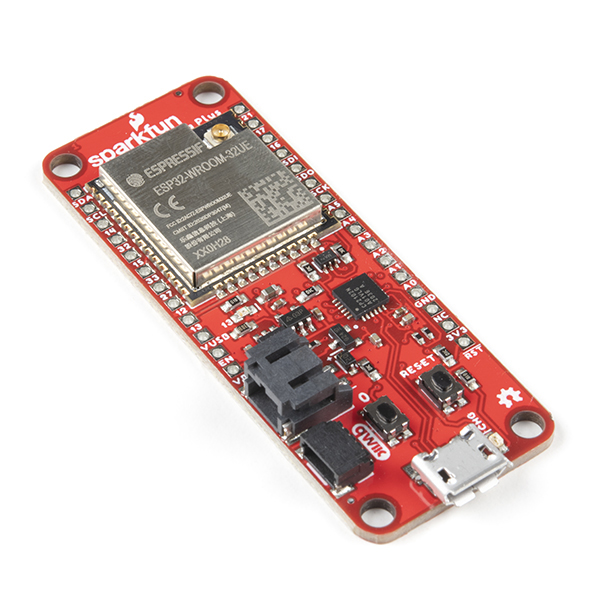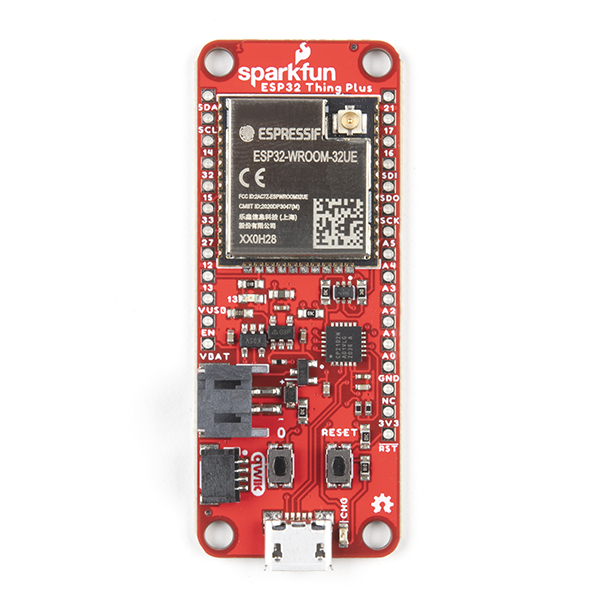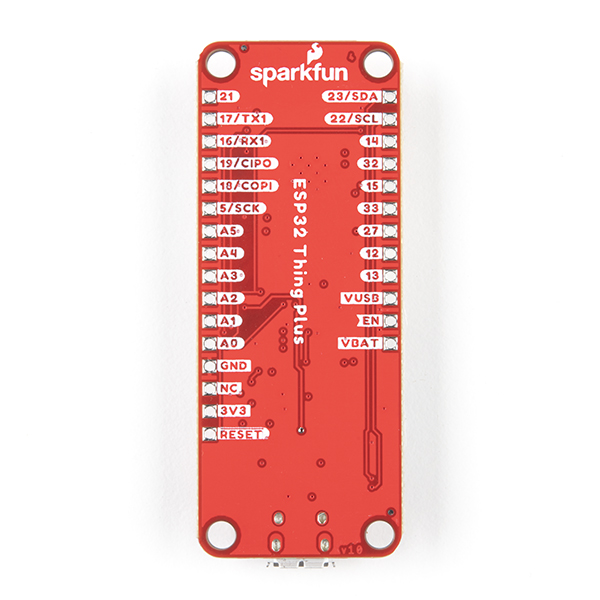SparkFun Thing Plus - ESP32 WROOM (U.FL)
The SparkFun ESP32 Thing Plus with U.FL is the next step to get started with Espressif IoT ideations while still enjoying all the amenities of the original ESP32 Thing. Espressif's ESP32 WROOM is a powerful WiFi and Bluetooth MCU module that targets a wide variety of applications. At the core of this module is the ESP32-D0WDQ6 chip which is designed to be both scalable and adaptive. To make the Thing Plus even easier to use, we've moved a few pins around to make the board Feather compatible and it utilizes our handy Qwiic Connect System which means no soldering or shields are required to connect it to the rest of your system!
Why the name? We lovingly call it the “Thing” because it's the perfect foundation for your Internet of Things project. The Thing does everything from turning on an LED to posting data with your chosen platform, and can be programmed just like any microcontroller. You can even program the Thing through the Arduino IDE by installing the updated ESP32 Arduino Core.
The ESP32 Thing plus integrates a rich set of peripherals, ranging from capacitive touch sensors, SD card interface, Ethernet, high-speed SPI, UART, I2S and I2C. Thanks to the onboard ESP32 WROOM module, the SparkFun Thing Plus features 16MB of flash memory, 520kB of internal SRAM, an integrated 802.11 BGN WiFi transceiver and dual-mode Bluetooth capabilities, a JST connector to plug in a LiPo battery, and a U.FL connector for your own antenna.
The SparkFun Qwiic Connect System is an ecosystem of I2C sensors, actuators, shields and cables that make prototyping faster and less prone to error. All Qwiic-enabled boards use a common 1mm pitch, 4-pin JST connector. This reduces the amount of required PCB space, and polarized connections mean you can’t hook it up wrong.
SparkFun Thing Plus - ESP32 WROOM (U.FL) Features
- ESP32 WROOM (U.FL) Module
- 21 Multifunctional GPIO
- Up to thirteen 12-bit ADC Channels
- Up to two DAC channels
- Up to sixteen PWM outputs
- Up to eight capacitive touch pins
- Up to three SPI Busses (only one is configured by default in the Arduino IDE)
- An available I2S Audio Output
- Up to two I2C Busses (only one is configured by default in the Arduino IDE)
- Up to two UARTs (only two are configured by default in the Arduino IDE, one UART is used for bootloading/debug)
- 21 Multifunctional GPIO
- Thing Plus (or Feather) Form-Factor:
- Dimensions: 2.55" x 0.9"
- Four Mounting Holes:
- 4-40 screw compatible
- 28 PTH Pins
- micro-B USB Connector
- 2-pin JST Connector for a LiPo Battery (not included)
- 4-pin JST Qwiic Connector
- LEDs:
CHG- Yellow battery charging indicator13- Blue status/test LED
- Buttons:
0Reset
- U.FL Connector
ESP32 WROOM (U.FL) General Features:
- Operating Voltage: 2.3 to 3.6 V
- 2.5 µA deep sleep current
- 80 mA average operating current
- Opterating Temperature: -40 to 85 °C
- Xtensa® Single-Core 32-bit LX6 Microprocessor (up to 240MHz)
- 448KB of ROM and 520KB SRAM
- 16MB of Embedded SPI flash storage
- Integrated 802.11b/g/n WiFi 2.4GHz transceiver
- Integrated dual-mode Bluetooth (classic and BLE)
- Hardware accelerated encryption (AES, SHA2, ECC, RSA-4096)
SparkFun Thing Plus - ESP32 WROOM (U.FL) Product Help and Resources
ESP32 Thing Plus Hookup Guide
March 7, 2019
Hookup guide for the ESP32 Thing Plus (Micro-B) using the ESP32 WROOM's WiFi/Bluetooth system-on-chip in Arduino.
SparkFun Qwiic Shield for Thing Plus Hookup Guide
January 30, 2020
A short guide for assembling and using the SparkFun Qwiic Shield for Thing Plus.
Core Skill: Programming
If a board needs code or communicates somehow, you're going to need to know how to program or interface with it. The programming skill is all about communication and code.
Skill Level: Competent - The toolchain for programming is a bit more complex and will examples may not be explicitly provided for you. You will be required to have a fundamental knowledge of programming and be required to provide your own code. You may need to modify existing libraries or code to work with your specific hardware. Sensor and hardware interfaces will be SPI or I2C.
See all skill levels
Core Skill: Electrical Prototyping
If it requires power, you need to know how much, what all the pins do, and how to hook it up. You may need to reference datasheets, schematics, and know the ins and outs of electronics.
Skill Level: Rookie - You may be required to know a bit more about the component, such as orientation, or how to hook it up, in addition to power requirements. You will need to understand polarized components.
See all skill levels
Comments
Looking for answers to technical questions?
We welcome your comments and suggestions below. However, if you are looking for solutions to technical questions please see our Technical Assistance page.
Customer Reviews
4.4 out of 5
Based on 10 ratings:
Better than an Arduino. IMO
Faster & cheaper than Arduino but can be programmed in the Arduino environment. It has built in WiFi, Bluetooth and battery management.
Works as advertised
Had an issue but the support team took care of it immediately. Great service.
Good product
The external antenna reliably extends the range to my WiFi access point.
Good product
The external antenna reliably extends the range to my WiFi access point.
Good product
The external antenna reliably extends the range to my WiFi access point.
ESP32 processor
The SparkFun thing plus is one of most amazing processors that I have ever used. It is relatively fast and has both WiFi and BLE capability in one package. I have also used its deep sleep mode to save the need for either a relay or a switch. My experience with programing the processor is that the Arduino interface is okay, the C++ is complicated, and the python assembler is limited. I presently use the Arduino because there are many libraries that allow one to build prototypes quickly. My problem is that they are black boxes and when I get into trouble I have a hard time figuring out what exactly is going on. The BLE library is an example.
Breakout for ESP-Prog Inline debugger
Pretty darn tutin awesome board. Would love to see two things though, examples for Bluetooth classic / audio profiles such as HFP and A2DP. There's great tutorials for classic serial connections and near field stuff, but honestly, I don't use any of the low energy.
I'd also LOVE to see a breakout for JTAG / inline debugger such as ESP-Prog. Would be even MORE awesome if there was a ESP-Prog JTAG to serial w/ second USB port to do inline debugging right on the chipset. That would be unstoppable. I'd build most everything with this board then.
Cannot complain though! Really sweet little board.
Good product, uncertain how to use it with other boards
I purchased this board for the processing speed of its chip and the availability of U.FL. With the current state of the industry struggling to get chips delivered this board is certainly a winner, particularly for my situation requiring longer-range, unidirectional WiFi.
The issue I face is that as a newbie I lack experience using this board with other Arduino boards. I finally realized that to use this board, the Thing Plus - ESP32 WROOM (U.FL) with other boards requires building a breadboard solution. Different pin layouts can be confusing and circuit design beyond the most basic can be problematic.
My verdict: the Thing Plus - ESP32 WROOM (U.FL) is excellent for my situation but my knowledge needs to catch up with my intended use.
Awsome board
It is very easy to setup a web page/server on this device. Other things are easy to setup to like free rtos, adc, and not limited to IO. Just be careful if your using the ADC2 that your not using wifi at the same time.
ESP32-WROOM-32UE
I bought a couple of 32E's and they work fine. Then I bought the 32UE and the sketches I used on the 32E don't work on the 32UE. I also can't find the board or library for the 32UE in PlatformIO.





Word of warning, the ADC on ESP32 is lackluster to be kind, and closer to 'garbage'. Problem #1, ADC module #2 isn't available when using Wifi. Problem #2 arose when tried to use ADC1...it has absolute garbage performance. Values under 0.1mv are flat out ignored, and the response is non linear. Additionally voltages that do register result in a lot of noise. I was only sampling once per second, so I wasn't trying max speed. Top range is configurable with an attenuation register, but by default it tops out at 2.2V. (VREF is not 3.3V!). This took a while to find out. Old Microchip PICs had better A2D performance a decade ago, I don't know why this is so bad. The rest of this product is great. dual core, easy to use wifi, and so on, with good Arduino support (plus ESP provides libraries to work around Arduino and give you full access). Just be sure to buy a Qwicc A2D module or supply your own a2d.
Hello how are you? I have version 1.0
And I think I have damaged the chip c2102n, because I can not get it to be recognized by the esptool.py
Now, I'm having trouble finding the c2102n chip, this could serve 24 pins?
https://es.farnell.com/silicon-labs/cp2102n-a02-gqfn24r/puente-usb-uart-40-a-85-c/dp/3387002
Can you use the QWIIC interface and pins 22-23 at the same time or are they wired together?
Edit: After looking at the schematic, it appears that they are tied together.
I am looking at the picture and I see what appears to be an RJ45 ethernet jack on there, and do not see the socket for the battery like on the older model. Where can I attach a Lithium Ion Battery? Would like to know before I purchase for a practice project at home.
It's the same socket as the older one.
Ahh ok, it must have been the viewing angle that made the Lithium Ion socket appear to me as an RJ45 ethernet jack. I didn't think that the socket would be that large. Thanks for the clarification.